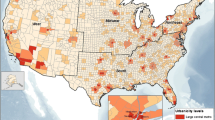Abstract
Convenience samples are used to determine HIV-related behaviors among men who have sex with men (MSM) without measuring the extent to which the results are representative of the broader MSM population. We compared results from a cross-sectional survey of MSM recruited from gay bars between June and October 2001 to a random digit dial telephone survey conducted between June 2002 and January 2003. The men in the probability sample were older, better educated, and had higher incomes than men in the convenience sample, the convenience sample enrolled more employed men and men of color. Substance use around the time of sex was higher in the convenience sample but other sexual behaviors were similar. HIV testing was common among men in both samples. Periodic validation, through comparison of data collected by different sampling methods, may be useful when relying on survey data for program and policy development.
Similar content being viewed by others
References
Berry, S. H., Duan, N., & Kanouse, D. E. (1996). Use of probability versus convenience samples of street prostitutes for research on sexually transmitted diseases and HIV risk behaviors: how much does it matter? In: R. Warnecke (Eds.). Health survey research methods conference proceedings. (pp. 93–97). Hyattsville, MD: Department of Public Health and Human Services.
Catania, J. A., Osmond, D., Stall, R., Pollack, L., Paul, J. P., Blower, S., Binson, D., Canchola, J. A., Mills, T. C., Fisher, L., Choi, K.-H., Porco, T., Turner, C., Blair, J., Henne, J., Bye, L., & Coates, T. J. (2001). The continuing HIV epidemic among men who have sex with men. American Journal of Public Health, 91, 907–914.
Centers for Disease Control and Prevention (2005). HIV/AIDS surveillance report, 2004, 16 (p. 10). Atlanta: Author.
Centers for Disease Control and Prevention (2004). HIV Testing Survey, 2002 (special surveillance report number 5 (p. 27). Atlanta: Author.
Centers for Disease Control, Prevention (1998). HIV testing among populations at risk for HIV infection—nine states, November 1995–December 1996. MMWR. Morbidity and Mortality Weekly Report, 47, 1086–1091.
Hecht, F. M., Chesney, M. A., Lehman, J. S., Osmond, D., Vranizan, K., Coman, S., Keane, D., Reingold, A., Bindman, A. B., & the MESH Study Group (2000). Does HIV reporting by name deter testing? AIDS, 14, 1801–1808.
Kellerman, S. E., Drake, A., Lansky, A., & Klevens, R. M. (2006). Use of and exposure to HIV prevention programs and services by persons at high risk for HIV. AIDS Patient Care and STDs, 20, 391–398.
Kellerman, S. E., Lehman, J. S., Lansky, A., Stevens, M. R., Hecht, F. M., & Bindman, A. B. (2002). HIV testing within at-risk populations in the United States and the reasons for seeking or avoiding HIV testing. JAIDS, 31, 202–210.
Lansky, A., Lehman, J. S., Gatwood, J., Hecht, R., & Fleming, P. L. (2002). Change in HIV testing patterns after implementation of name-based HIV surveillance reporting in New Mexico. American Journal of Public Health, 92, 1757.
Lansky, A., MacKellar, D., Gallagher, K. M., Lin, L. S., Sullivan, P. S., & Onorato, I. M. (2006). Letter to the Editor. Sexually Transmitted Diseases, 33, 272–273.
MacKellar, D., Valleroy, L., Karon, J., Lemp, G., & Janssen, R. (1996). The young men’s survey: methods for estimating HIV seroprevalence and risk factors among young men who have sex with men. Public Health Report, 111(Suppl. 1), 138–144.
Magnani, R., Sabin, K., Saidel, T., & Heckathorn, D. M. (2005). Review of sampling hard-to-reach and hidden populations for HIV surveillance. AIDS, 19(Suppl. 2), S67–S72.
Meyer, I. H., & Colten, M. E. (1999). Sampling gay men: random digit dialing versus sources in the gay community. Journal of Homosexuality, 37, 99–110.
Pollack, L. M., Osmond, D. H., Paul, J. P., & Catania, J. A. (2005). Evaluation of the Center for Disease Control and Prevention’s HIV behavioral surveillance of men who have sex with men: sampling issues. Sexually Transmitted Diseases, 32, 581–589.
Schwarcz, S., Scheer, S., McFarland, W., Katz, M., Valleroy, L., & Catania, J. (in press). Prevalence of HIV infection and predictors of high transmission sexual risk behaviors: results from a probability sample of men who have sex with men, San Francisco. American Journal of Public Health.
Schwarcz, S., Stockman, J., Delgado, V., & Scheer, S. (2004). Does name-based HIV reporting deter high-risk persons from HIV testing? Results from San Francisco. Journal of Acquired Immune Deficiency Syndromes, 3, 93–96.
Acknowledgments
Funding for this study was provided through cooperative agreements from the Centers for Disease Control and Prevention numbers. Disclaimer. The findings and conclusions in this report are those of the authors and do not necessarily represent the views of the Centers for Disease Control and Prevention.
Author information
Authors and Affiliations
Corresponding author
Rights and permissions
About this article
Cite this article
Schwarcz, S., Spindler, H., Scheer, S. et al. Assessing Representativeness of Sampling Methods for Reaching Men Who Have Sex with Men: A Direct Comparison of Results Obtained from Convenience and Probability Samples. AIDS Behav 11, 596–602 (2007). https://doi.org/10.1007/s10461-007-9232-9
Received:
Accepted:
Published:
Issue Date:
DOI: https://doi.org/10.1007/s10461-007-9232-9




